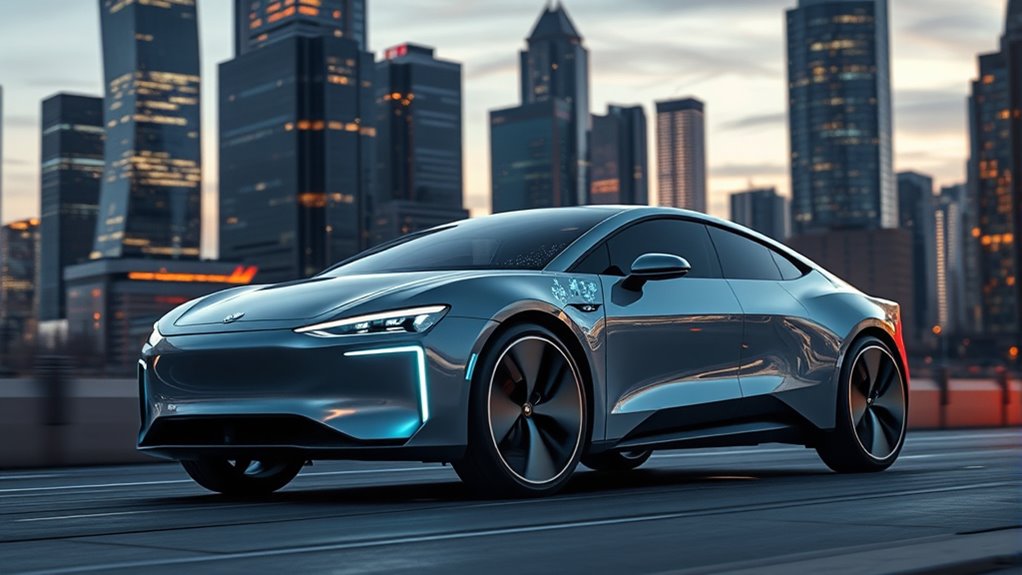Imagine a car that never needs a pit stop for fuel or a battery replacement—that’s the promise of solid-state batteries. These advanced energy cells could soon outperform traditional lithium-ion options, offering longer range, faster charging, and enhanced safety. As research progresses and manufacturing costs drop, you might wonder if they’re truly capable of replacing the combustion engine forever. The story behind this technological leap is more complex than it seems.
Key Takeaways
- Solid-state batteries offer higher energy density, enabling longer-range electric vehicles that can outperform traditional combustion engines.
- Enhanced safety features reduce fire risks, making EVs more reliable and appealing to consumers.
- Longer lifespan and faster charging reduce maintenance costs and improve overall usability of electric vehicles.
- Manufacturing advancements are lowering costs, bringing solid-state battery-powered vehicles closer to mass-market affordability.
- Widespread adoption of solid-state batteries could accelerate the shift to cleaner, sustainable transportation, replacing internal combustion engines entirely.

Have you ever wondered what could make batteries safer, more efficient, and longer-lasting? It’s a question that’s driving innovation in the energy storage world, and solid-state batteries are emerging as a promising answer. Unlike traditional lithium-ion batteries that rely on liquid electrolytes, solid-state versions use a solid electrolyte, which offers significant advantages in battery longevity and safety. But releasing their full potential isn’t without hurdles. Manufacturing challenges are among the main obstacles, as producing these batteries at scale involves precise engineering and high-quality materials. Achieving consistent quality and performance across large quantities remains a complex task, slowing down widespread adoption. Still, the potential benefits make overcoming these challenges worthwhile, especially as demand for safer, higher-capacity batteries continues to grow.
One of the biggest benefits of solid-state batteries is their impressive battery longevity. Because they use solid electrolytes, these batteries are less prone to the degradation processes that plague liquid electrolytes, such as dendrite formation—tiny, needle-like structures that can cause short circuits. This means they can endure more charge-discharge cycles before performance drops, extending the lifespan of the battery. For you, that translates into vehicles that need fewer replacements and devices that stay reliable longer. Plus, solid electrolytes are less flammable, considerably reducing the risk of fires caused by thermal runaway—another leap forward in safety. This combination of durability and safety makes solid-state batteries highly attractive for electric vehicles, portable electronics, and renewable energy storage. Additionally, advancements in solid electrolyte materials are crucial to overcoming current manufacturing hurdles and unlocking their full potential.
Solid-state batteries last longer and are safer, reducing fire risks and device replacements.
However, manufacturing challenges continue to slow their widespread deployment. Creating a solid electrolyte that’s both highly conductive and stable over time is tricky. It requires advanced materials that can withstand repeated charging cycles without cracking or losing effectiveness. Producing these materials consistently at scale demands sophisticated fabrication techniques and strict quality control. Additionally, integrating solid electrolytes into existing manufacturing lines involves rethinking conventional processes, which can be costly and complex. As researchers and manufacturers work to overcome these issues, incremental improvements are being made, but mass production still faces hurdles. Despite these challenges, investment and innovation are accelerating, hinting that solid-state batteries may soon become more accessible and affordable.
In the end, if these manufacturing challenges are surmounted, solid-state batteries could revolutionize energy storage. They promise longer-lasting, safer batteries that could finally push electric vehicles past traditional combustion engines in terms of efficiency and reliability. For you, that means cleaner transportation options, reduced maintenance, and a step closer to a sustainable future. While there’s still work to do, the progress made so far suggests that solid-state technology is on the brink of transforming how we power our lives.
Conclusion
As you can see, solid-state batteries are truly changing the game, promising safer, longer-lasting power for your vehicle. With ongoing innovations, they’re bringing us closer to a future where electric vehicles can finally replace combustion engines. Remember, Rome wasn’t built in a day—patience and progress go hand in hand. As these batteries become more accessible, cleaner and more reliable transportation is within reach, making the old ways a thing of the past.









